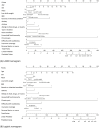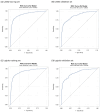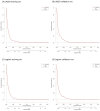Development of a machine learning-based predictive nomogram for screening children with juvenile idiopathic arthritis: a pseudo-longitudinal study of 223,195 children in the United States
- PMID: 40510579
- PMCID: PMC12158982
- DOI: 10.3389/fpubh.2025.1531764
Development of a machine learning-based predictive nomogram for screening children with juvenile idiopathic arthritis: a pseudo-longitudinal study of 223,195 children in the United States
Abstract
Background: Juvenile idiopathic arthritis (JIA) is a prevalent chronic rheumatological condition in children, with reported prevalence ranging from 12. 8 to 45 per 100,000 and incidence rates from 7.8 to 8.3 per 100,000 person-years. The diagnosis of JIA can be challenging due to its symptoms, such as joint pain and swelling, which can be similar to other conditions (e.g., joint pain can be associated with growth in children and adolescents).
Methods: The National Survey of Children's Health (NSCH) database (2016-2021) of the United States was used in the current study. The NSCH database is funded by the Health Resources and Services Administration and Child Health Bureau and surveyed in all 50 states plus the District of Columbia. A total of 223,195 children aged 0 to 17 were analyzed in this study. A least absolute shrinkage and selection operator (LASSO) logistic regression and stepwise logistic regression were used to select the predictors, which were used to create the nomograms to predict JIA.
Results: A total of 555 (248.7 per 100,000) JIA cases were reported in the NSCH. In the LASSO model, the receiver operating characteristic curve demonstrated excellent discrimination, with an area under the curve (AUC) of 0.9002 in the training set and 0.8639 in the validation set. Of the 16 variables selected by LASSO, 13 overlapped with those from the stepwise model. The regression achieved an AUC of 0.9130 in the training set and 0.8798 in the validation set. Sensitivity, specificity, and accuracy were 79.1%, 90.2%, and 90.2% in the training set, and 69.0%, 90.9%, and 90.8% in the validation set.
Discussion: Using two well-validated predictor models, we developed nomograms for the early prediction of JIA in children based on the NSCH database. The tools are also available for parents and health professionals to utilize these nomograms. Our easy-to-use nomograms are not intended to replace the standard diagnostic methods. Still, they are designed to assist parents, clinicians, and researchers in better-estimating children's potential risk of JIA. We advise individuals utilizing our nomogram model to be mindful of potential pre-existing selection biases that may affect referrals and diagnoses.
Keywords: LASSO; NSCH; chronic rheumatology; juvenile idiopathic arthritis; machine learning; nomogram; pediatric arthritis; pediatric joint inflammation.
Copyright © 2025 Lee, Gor, Sprong, Shrestha, Huang and Hollender.
Conflict of interest statement
The authors declare that the research was conducted without any commercial or financial relationships that could be construed as a potential conflict of interest.
Figures





Similar articles
-
Construction and validation of a machine learning model for the diagnosis of juvenile idiopathic arthritis based on fecal microbiota.Front Cell Infect Microbiol. 2024 Mar 8;14:1371371. doi: 10.3389/fcimb.2024.1371371. eCollection 2024. Front Cell Infect Microbiol. 2024. PMID: 38524178 Free PMC article.
-
Construction and evaluation of a mortality prediction model for patients with acute kidney injury undergoing continuous renal replacement therapy based on machine learning algorithms.Ann Med. 2024 Dec;56(1):2388709. doi: 10.1080/07853890.2024.2388709. Epub 2024 Aug 19. Ann Med. 2024. PMID: 39155811 Free PMC article.
-
A Diagnostic Prediction Model for Separating Juvenile Idiopathic Arthritis and Chronic Musculoskeletal Pain Syndrome.J Pediatr. 2022 Dec;251:164-171.e6. doi: 10.1016/j.jpeds.2022.04.029. Epub 2022 Apr 20. J Pediatr. 2022. PMID: 35460700
-
Genomic risk scores for juvenile idiopathic arthritis and its subtypes.Ann Rheum Dis. 2020 Dec;79(12):1572-1579. doi: 10.1136/annrheumdis-2020-217421. Epub 2020 Sep 4. Ann Rheum Dis. 2020. PMID: 32887683 Free PMC article.
-
Folic acid supplementation and malaria susceptibility and severity among people taking antifolate antimalarial drugs in endemic areas.Cochrane Database Syst Rev. 2022 Feb 1;2(2022):CD014217. doi: 10.1002/14651858.CD014217. Cochrane Database Syst Rev. 2022. PMID: 36321557 Free PMC article.
References
-
- Thatayatikom A, De Leucio A. Juvenile Idiopathic Arthritis (JIA). Bethesda, MD: StatPearls, National Library of Medicine (NLM). (2020).
-
- Berntson L, Gäre BA, Fasth A, Herlin T, Kristinsson J, Lahdenne P, et al. Incidence of juvenile idiopathic arthritis in the Nordic countries. A population based study with special reference to the validity of the ILAR and EULAR criteria. J Rheumatol. (2003) 30:2275–82. - PubMed
-
- Danner S, Sordet C, Terzic J, Donato L, Velten M, Fischbach M, et al. Epidemiology of juvenile idiopathic arthritis in Alsace, France. J Rheumatol. (2006) 33:1377–81. - PubMed
MeSH terms
LinkOut - more resources
Full Text Sources
Medical

